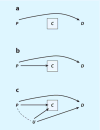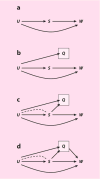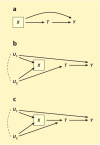Endogenous Selection Bias: The Problem of Conditioning on a Collider Variable
- PMID: 30111904
- PMCID: PMC6089543
- DOI: 10.1146/annurev-soc-071913-043455
Endogenous Selection Bias: The Problem of Conditioning on a Collider Variable
Abstract
Endogenous selection bias is a central problem for causal inference. Recognizing the problem, however, can be difficult in practice. This article introduces a purely graphical way of characterizing endogenous selection bias and of understanding its consequences (Hernán et al. 2004). We use causal graphs (direct acyclic graphs, or DAGs) to highlight that endogenous selection bias stems from conditioning (e.g., controlling, stratifying, or selecting) on a so-called collider variable, i.e., a variable that is itself caused by two other variables, one that is (or is associated with) the treatment and another that is (or is associated with) the outcome. Endogenous selection bias can result from direct conditioning on the outcome variable, a post-outcome variable, a post-treatment variable, and even a pre-treatment variable. We highlight the difference between endogenous selection bias, common-cause confounding, and overcontrol bias and discuss numerous examples from social stratification, cultural sociology, social network analysis, political sociology, social demography, and the sociology of education.
Keywords: causality; confounding; directed acyclic graphs; identification; selection.
Figures













References
-
- Alderman H, Behrman J, Kohler H, Maluccio JA, Watkins SC. Attrition in longitudinal household survey data: some tests for three developing-country samples. Demogr Res. 2001;5:79–124.
-
- Allen MP, Lincoln A. Critical discourse and the cultural consecration of American films. Soc Forces. 2004;82(3):871–94.
-
- Alwin DH, Hauser RM. The decomposition of effects in path analysis. Am Sociol Rev. 1975;40:37–47.
-
- Amin V. Returns to education: evidence from UK twins: comment. Am Econ Rev. 2011;101(4):1629–35.
-
- Angrist JD, Imbens GW, Rubin DB. Identification of causal effects using instrumental variables. J Am Stat Assoc. 1996;8:328–36.
Grants and funding
LinkOut - more resources
Full Text Sources
Other Literature Sources
